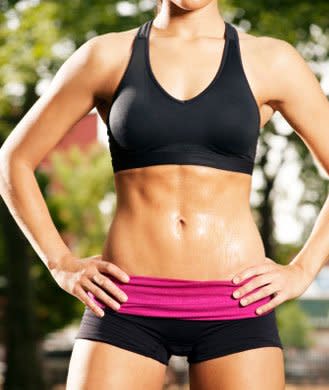How to Choose a Perfect Sports Bra to Support Your Girls

First rule of fighting sag: The stakes get higher when you exercise. With each running stride, breasts move not only up and down but also side to side and in and out, tracing a butterfly pattern. Unsupported, the average A cup travels about an inch and a half in each direction, and a D cup bounces two to three inches.
A good sports bra can cut that movement in half—by 53 to 59 percent for As and Ds, respectively—which is key to sparing the support structures in your breast, says Joanna Wakefield-Scurr, Ph.D., a biomechanist at the University of Portsmouth in the United Kingdom who studies bounce. Because breasts are made of soft tissue—alas, not muscle—what holds them up is the surrounding skin and the internal Cooper's ligaments, a web of springy coils that are built to rebound until jumping, genetics, and gravity catch up with them. "Any permanent stretching of these can cause the breasts to droop," Scurr says.
Your breast defense? A good offense. Maximize your lift with these expert sports bra tips.
How to Find Your Fit
When we polled top bra-fitting pros for the number-one mistake women make in choosing a sports bra, they were unanimous: wearing a smaller cup and larger band than you need. Sure enough, nearly every tester whom we sent to the specialty shops Intimacy and Linda's Bra Salon in New York City for fittings returned with a two-inch-smaller band and a larger cup size—As and double Ds alike. (Related: These Companies are Making Shopping for Sports Bras Suck Less)
They’re not the only ones. It's so common that LaJean Lawson, Ph.D., adjunct professor of exercise and sport science at Oregon State university and Champion's 'go-to guru' in sports bra research, design, and testing for more than 25 years, estimates that only 15 to 20 percent of women are wearing the best bra for their shape. If you can't get to an expert fitter in your local department store to help you figure out how to choose a perfect sports bra, check out Champion’s Sports Bra Guide or Brook’s Sports Bra Fit Guide for sizing how-tos. Then check out the information below to get the skinny on which options work for you.
How to Choose a Perfect Sports Bra
Compression or encapsulation?
Compression: Shelf bra styles work for smaller cup sizes (A and B) or for low- to moderate-impact workouts.
Encapsulation: Sports bras with individual cups are better for larger-breasted women than compression-style ones, Scurr's research found.
Racerback or wide straps?
Racerback: Because they cinch in back, the straps anchor the bra closer to the body, providing more support. (Related: Nike is Revolutionizing the Sports Bra and Extending Their Sizes)
Wide straps: Shoulder straps help distribute weight better than T-backs (key for bigger cups) and are more likely to be adjustable and padded.
Pullover or back clasp?
Pullover: Tank styles typically cover the back more than clasps, but those with allover stretch lack the rigid front straps, adjustability, and support to anchor large chests.
Back clasp: Clasps let you tighten the band, from which 70 percent of the bra's support comes. This is especially vital for larger breasts, which place more demand on the band.
What to Do Before You Buy a Sports Bra
How do you know that the sports bra you pulled off the rack will hold up your, er, rack (especially if it feels like wearing nothing)? "Support comes from three points on a sports bra: the straps, the cups, and the band, including the side panels," says Susan Sokolowski, senior innovation manager for Nike in Beaverton, Oregon.
This three-step dressing room experiment is a great test for how to choose the perfect sports bra:
Straps: Hold the top of one strap and the center of the corresponding cup, then pull. Whether they're adjustable or not, the less stretchy the front straps, the more motion control they'll provide.
Cups: Repeat a similar stretch test by tugging the top and bottom of each cup; the less give, the more motion control. Then put on the bra. Whether it's a compression or an encapsulation style, the cup should hold the whole breast—no spillage. If it doesn't, choose the next larger cup size.
Band and side panels: Slide a finger under the band between your breasts; you should not be able to pull it more than an inch from your chest. (For an adjustable band style, set the clasp on the first eyelet; if you have to use the last eyelet to get a snug fit, you're better off with a smaller band.) Next, reach your arms overhead; if the band creeps up, it's too big. In both cases, pick a smaller size.
How to Make Your Sports Bra Last
Follow these dos and don'ts from Joanne Sessler, design director for Champion. (And don’t fall victim to this crazy-common sports bra mistake.)
Wash the bra in cold water with mild detergent. Avoid fabric softener and bleach.
Dry it flat or line dry it. For the dryer, use the cold tumble cycle only: Heat breaks down spandex.
Replace the bra if the ends of the spandex fibers start showing or the fabric no longer snaps back into shape. (Average lifespan: nine to 15 months of regular wear.)